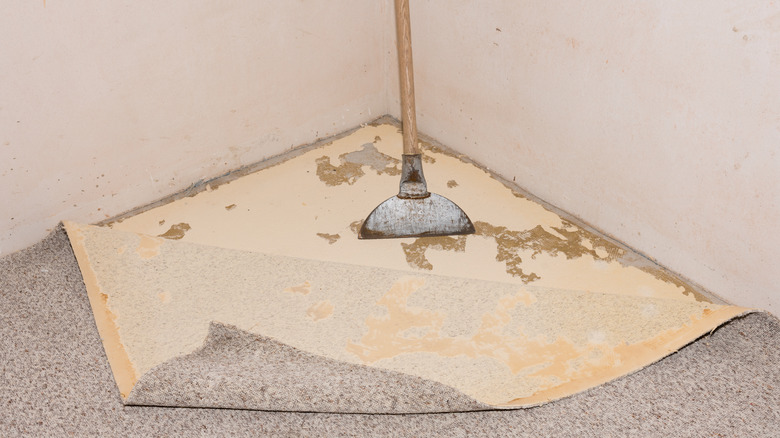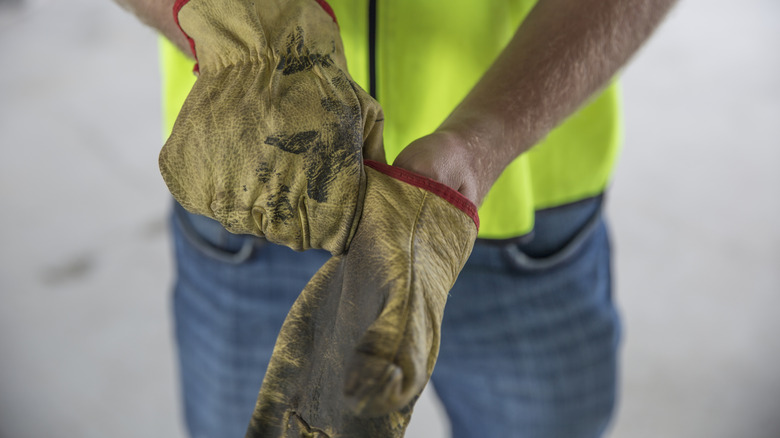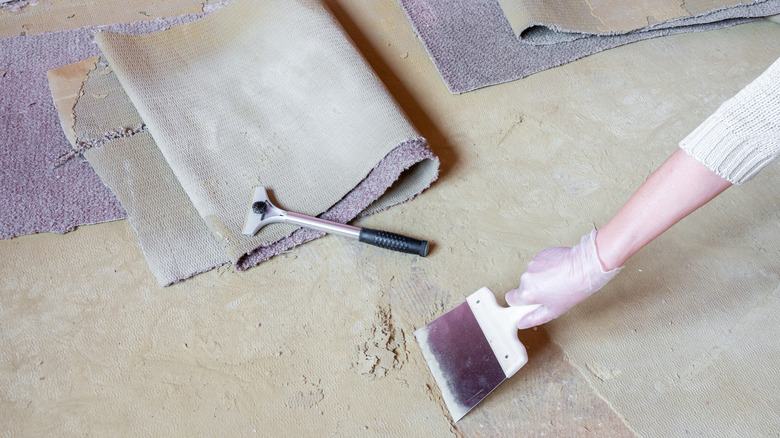Tips And Tricks For Removing Stubborn Carpet Glue
Removing carpet glue can feel like trying to scrape gum off a sidewalk in summer — it's sticky, messy, and downright frustrating. However, with the right approach (and maybe a little patience), you can banish that stubborn glue without losing your mind. Whether you want to get rid of your carpet flooring for aesthetic purposes or are working to repair damage, we've got some handy tricks up our sleeves. If you use a heat gun, floor sander, or solvents, you can cut through the stuck-on mess in no time.
If you've ever melted marshmallows for s'mores, you already understand using heat to soften carpet glue. A heat gun — or, if you're in a pinch, your hair dryer — can make the glue soft, gooey, and way easier to scrape off. Hold the heat gun a few inches from the surface and let it work its magic for about 30 seconds. You'll notice the glue starts to loosen up. Grab your putty knife or scraper, and gently peel the glue away while it's still warm.
If heat alone isn't cutting it, it's time to get physical — literally. A sander can help you break up those extra sticky patches. Scrub using circular motions, but don't go overboard. If heat and elbow grease aren't doing the trick, try solvents. For concrete surfaces, mineral spirits and acetone can help break down the adhesive without causing damage. On the other hand, if you're dealing with plywood, opt for gentler solvents like a water and dish soap mixture. To use the solvent, apply it over the glued areas and use a putty knife to remove it after 10 to 15 minutes.
Safety tips for removing carpet glue
Removing carpet glue on any type of subfloor might seem straightforward, but it can involve tools, heat, and solvents that require caution to use. With that in mind, you must always stay safe during the process. For starters, always wear protective gear. Between sharp scrapers, heat tools, and strong-smelling solvents, it's best to suit up. Wear gloves to protect your hands from cuts and chemicals. Slip on safety goggles to shield your eyes from flying glue bits or splashes of solvent. And, if you're working with strong adhesives, a mask is your best friend. Your lungs will thank you later.
Next, always test solvents before use. Different floors react differently to chemicals, and you don't want to discover too late that your adhesive remover also damages your subfloor and ends up showing signs it needs replacement. Pick a small, hidden spot — like the corner of the room — and apply a tiny bit of the solvent. Wait a few minutes to see if there's any discoloration or damage. If the test area looks good, you're clear to proceed. If not, you dodged a disaster.
Lastly, follow product instructions. We know that reading instructions isn't exactly exciting, but those tiny words on the label are there for a reason. Whether it's a chemical solvent, a DIY concoction, or a tool you've never used before, follow the guidelines to the letter. Overusing a product or leaving it on for too long can lead to a sticky situation. Instructions also include helpful tips, like ventilation requirements or time limits, to save you from headaches (and costly mistakes).
How to prevent damage to your flooring during glue removal
Alright, you're armed with tools, techniques, and safety tips. It's time to make sure your floors come out of this process looking as fabulous as they deserve. The first tip is to be patient (yes, that thing you lose when you step on a sticky patch for the hundredth time). Rushing through the process with brute force will end with scratches, gouges, or a slightly charred floor if you're too enthusiastic with the heat gun. Instead, work in small sections and be gentle.
Even if you are planning a full home renovation amid rising inflation, you should protect the surrounding areas with plastic sheeting, painter's tape, or damp cloths to catch drips and splashes. If you're sanding, lay down drop cloths to minimize dust spreading. Most importantly, clean as you go. Letting glue bits pile up can lead to accidental scuffs and sticky footprints that somehow end up in the one place you didn't want them.


